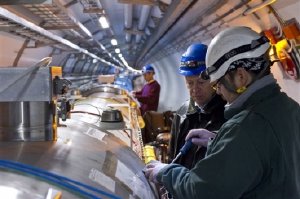Feb 5 2010
In December, the Large Hadron Collider, the world's largest particle accelerator, shattered the world record for highest energy particle collisions.
 Workers examine a new Quench Protection System at CERN in January.
Image courtesy of CERN
Workers examine a new Quench Protection System at CERN in January.
Image courtesy of CERN
This week, team led by researchers from MIT, CERN and the KFKI Research Institute for Particle and Nuclear Physics in Budapest, Hungary, completed work on the first scientific paper analyzing the results of those collisions. Its findings show that the collisions produced an unexpectedly high number of particles called mesons — a factor that will have to be taken into account when physicists start looking for more rarer particles and for the theorized Higgs boson.
“This is the very first step in a long road to performing extremely sensitive analyses that can detect particles produced only in one in a billion collisions,” says Gunther Roland, MIT associate professor of physics and an author of the new paper.
Roland and MIT professors Wit Busza and Boleslaw Wyslouch, who are members of the CMS (compact muon solenoid) collaboration, were among the study leaders. The CMS collaboration runs one of four detectors at the collider.
The Large Hadron Collider (LHC), located underground near Geneva, Switzerland, started its latest run in late November. On Dec. 8, the proton beams around the 17-mile ring collided at a peak energy of 2.36 tera electron volts (TeV), breaking the previous record of 1.96 TeV achieved at the Fermi National Accelerator Lab. Because of Einstein’s equation, E=mc2, which correlates mass and energy, higher energy levels should produce heavier particles — possibly including some never seen before.
In the new paper, submitted to the Journal of High Energy Physics by CMS, the physicists analyzed the number of particles produced in the aftermath of the high-energy collisions. When protons collide, their energy is predominantly transformed into particles called mesons — specifically, two types of mesons known as pions and kaons.
To their surprise, the researchers that the number of those particles increased faster with collision energy than was predicted by their models, which were based on results of lower-energy collisions.
Taking the new findings into account, the team is now tuning its predictions of how many of those mesons will be found during even higher energy collisions. When those high-energy experiments are conducted, it will be critical to know how many such particles to expect so they can be distinguished from more rare particles.
“If we’re looking for rare particles later on, these mesons will be in the background,” says Roland. “These results show us that our expectations were not completely wrong, but we have to modify things a bit.”
Using the Large Hadron Collider, physicists hope to eventually detect the Higgs boson, a particle that is theorized to give all other particles their mass, as well as evidence for other physical phenomena such as supersymmetry, extra dimensions of space and the creation of a new form of matter called quark-gluon plasma (QGP). The new data provide an important reference point when CMS will look for signatures of QGP creation in collisions of lead ions at the LHC later this year.
The CMS team, which includes more than 2,000 scientists around the world, has 45 members (including faculty, students and research scientists) from the MIT Laboratory for Nuclear Science’s Particle Physics Collaboration and heavy-ion research groups.
The Large Hadron Collider is capable of creating collisions up to 14 TeV, but scientists are gradually easing the machine up to that level to try to avoid safety issues that have arisen in the past. In September 2008, the collider had to be shut down for several months after a connector joining two of the collider’s magnets failed, causing an explosion and leakage of the liquid helium that cools the magnets.
During the collider’s next run in March, researchers hope to create collisions of 7 TeV, says Roland. The success of the latest effort “makes us extremely optimistic about the detector,” he says. “It performed beautifully during the run.”